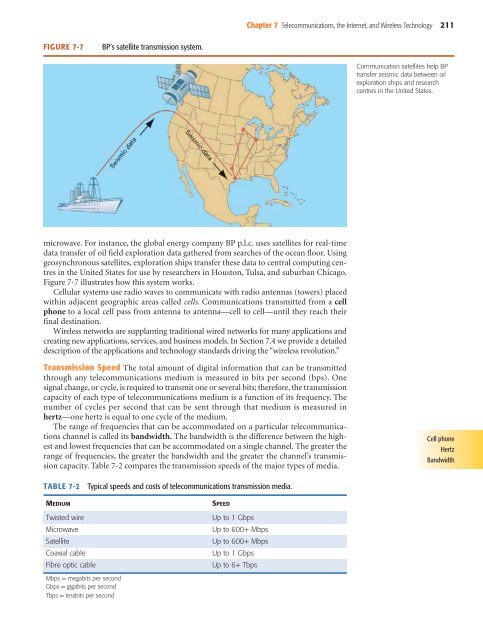Telecommunications, the Internet, and Wireless ... - Pearson Canada
Telecommunications, the Internet, and Wireless ... - Pearson Canada
Telecommunications, the Internet, and Wireless ... - Pearson Canada
You also want an ePaper? Increase the reach of your titles
YUMPU automatically turns print PDFs into web optimized ePapers that Google loves.
Chapter 7 <strong>Telecommunications</strong>, <strong>the</strong> <strong>Internet</strong>, <strong>and</strong> <strong>Wireless</strong> Technology 211<br />
FIGURE 7-7<br />
BP’s satellite transmission system.<br />
Communication satellites help BP<br />
transfer seismic data between oil<br />
exploration ships <strong>and</strong> research<br />
centres in <strong>the</strong> United States.<br />
microwave. For instance, <strong>the</strong> global energy company BP p.l.c. uses satellites for real-time<br />
data transfer of oil field exploration data ga<strong>the</strong>red from searches of <strong>the</strong> ocean floor. Using<br />
geosynchronous satellites, exploration ships transfer <strong>the</strong>se data to central computing centres<br />
in <strong>the</strong> United States for use by researchers in Houston, Tulsa, <strong>and</strong> suburban Chicago.<br />
Figure 7-7 illustrates how this system works.<br />
Cellular systems use radio waves to communicate with radio antennas (towers) placed<br />
within adjacent geographic areas called cells. Communications transmitted from a cell<br />
phone to a local cell pass from antenna to antenna—cell to cell—until <strong>the</strong>y reach <strong>the</strong>ir<br />
final destination.<br />
<strong>Wireless</strong> networks are supplanting traditional wired networks for many applications <strong>and</strong><br />
creating new applications, services, <strong>and</strong> business models. In Section 7.4 we provide a detailed<br />
description of <strong>the</strong> applications <strong>and</strong> technology st<strong>and</strong>ards driving <strong>the</strong> “wireless revolution.”<br />
Transmission Speed The total amount of digital information that can be transmitted<br />
through any telecommunications medium is measured in bits per second (bps). One<br />
signal change, or cycle, is required to transmit one or several bits; <strong>the</strong>refore, <strong>the</strong> transmission<br />
capacity of each type of telecommunications medium is a function of its frequency. The<br />
number of cycles per second that can be sent through that medium is measured in<br />
hertz—one hertz is equal to one cycle of <strong>the</strong> medium.<br />
The range of frequencies that can be accommodated on a particular telecommunications<br />
channel is called its b<strong>and</strong>width. The b<strong>and</strong>width is <strong>the</strong> difference between <strong>the</strong> highest<br />
<strong>and</strong> lowest frequencies that can be accommodated on a single channel. The greater <strong>the</strong><br />
range of frequencies, <strong>the</strong> greater <strong>the</strong> b<strong>and</strong>width <strong>and</strong> <strong>the</strong> greater <strong>the</strong> channel’s transmission<br />
capacity. Table 7-2 compares <strong>the</strong> transmission speeds of <strong>the</strong> major types of media.<br />
Cell phone<br />
Hertz<br />
B<strong>and</strong>width<br />
TABLE 7-2<br />
Typical speeds <strong>and</strong> costs of telecommunications transmission media.<br />
MEDIUM<br />
SPEED<br />
Twisted wire<br />
Microwave<br />
Satellite<br />
Coaxial cable<br />
Fibre optic cable<br />
Up to 1 Gbps<br />
Up to 600+ Mbps<br />
Up to 600+ Mbps<br />
Up to 1 Gbps<br />
Up to 6+ Tbps<br />
Mbps = megabits per second<br />
Gbps = gigabits per second<br />
Tbps = terabits per second
















